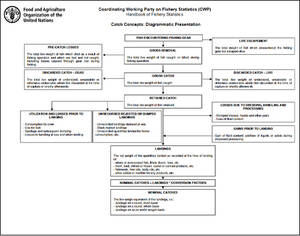Catch and landings
The overall aim for statistics on catch and landings is to report on fisheries contribution to the national economy, to the provision of food (subsistence) and on the total removal of fish and other organisms from their environment. Catch statistics are internationally reported as nominal catch which refers to the landed weight of products converted to a live weight basis. There are fisheries where the number of individuals caught is also required to be reported. However, fisheries impact on the ecosystem goes beyond the landed fish and includes other organisms impacted by the fishing gear. Some of these organisms are brought on deck and later discarded. The various components of the catch are described in the catch concept diagram and the definitions of the catch components provided below.
Catch and landings statistics are for many purposes required as very detailed data e.g. broken down by fleet, gear, season, target species and geographic area or fishing zone. The nationality of landings follows the vessel flag state principle as described in nationality of catch and landings.
National and regional fisheries organizations publish annually catch statistics in different forms. FAO collects and collates national reports with the goal of disseminating global capture production statistics. These statistics are summarized in "FAO Statistical Yearbooks" and are available in more details from the FAO Fisheries and Aquaculture Statistics website. When using published catch and landings statistics it is to be recognized that the catch of certain species (e.g. discarded catch and bycatch) may be under-reported or not reported in some fisheries.
The following definitions are provided for the purpose of collecting statistical data.
- Live weight: Total weight of fish when captured, estimated as if it was alive and prior to processing.
- Retained catch: Estimated component of the catch which is retained on board during a fishing trip (refer catch concept diagram). An estimate of the retained catch is reported as total live weight of fish retained and in some fisheries the number of individuals retained is also required to be reported. If a retained catch is intended for aquaculture, then for the purpose of fishery and aquaculture statistics that retained catch is required to be recorded as unrecorded, rejected or dumped landings and any post-release mortality of that catch is required to be recorded as discarded catch.
- Product weight: Weight of a fish product, often measured at-sea at the conclusion of processing. Information on product type, product homogeneity and conversion factors is also required in order to interpret product weight. As for landed weight, relevant when calculating the value of the catch.
- Landed weight: Weight of a product at the time of landing, regardless of the state in which the product is landed. That is, the fish may be inter alia whole, gutted or filleted. Consequently, this measure is of limited use for further analysis except where information is available on product type and homogeneity. Where more detailed analysis of the data is required, the landed weight is generally converted to a more meaningful measure often by use of a conversion factor (refer conversion factors), the most frequently used measure being nominal catch (refer below). The landed weight is relevant in economic analysis being the one to which first-hand sales prices refer.
- Nominal catch (also referred to as nominal landings): Landed weight converted to a live weight basis often by use of a conversion factor. Nominal catch is often referred to as the live weight equivalent of the landed weight or shortened to the live weight, and in some national publications it is also referred to as landings on a round, fresh basis, landings on a round, whole basis or landings on an ex-water basis. Care should be taken when referring to the nominal catch as the catch since in many situations the catch includes discarded components which are not landed (refer catch concept diagram). Often, in further processing the data, conversion factors are applied to the individual products (i.e. landed weight) which express the weight in a more homogenous way. Once verified, nominal catch is also in many cases the definitive declaration of what was caught and the amount which is applied against quotas or reported by a country.
- Discarded catch: Estimated component of the catch which is the total live weight of undersized, unsaleable or otherwise undesirable whole fish and other aquatic organisms which are discarded at the time of the capture or shortly afterwards (refer catch concept diagram). Discarded catch refers to whole fish and other aquatic organisms discarded dead or alive, and may include species taken as bycatch. Discarding in some fisheries is prohibited.
- Bycatch: Component of the catch which represents non-targeted fish associated with the catch of the target species or group towards which fishing effort is directed, or other aquatic organisms taken incidentally during the course of fishing (e.g. birds, mammals, reptiles, invertebrates). Some or all of the bycatch may be returned to the sea as discarded catch, either dead or alive. The catch taken incidentally is also referred to as incidental catch.
Data collection
In industrialized fisheries catches are often recorded in logbooks and these data may be used to derive catch statistics. However, the accuracy of weights measured at-sea and recorded in logbooks depends on the available weighing technology and/or the experience of the person making a visual assessment of the volume and composition of a catch.
Non-reporting of nominal catch is a major concern in some fisheries. Further, many national statistical publications do not use the terms associated with catch and landings with the precise meanings as described in this section. In such publications, nominal catches may in fact refer to the landed weights of products. However, only where the primary production (used in the economic and not the biological sense) is landed as whole fish is it correct to refer to such quantities as nominal catch.

